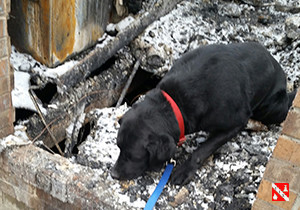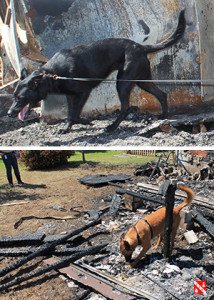
As technology continues to advance and improve, there is one steadfast, “low-tech” tool available to fire investigators. Dogs, man’s best friend, have remained as effective from their introduction into the process more than 30 years ago to today. The accelerant detection canine is trained to locate ignitable liquids, specifically liquids which can be used as accelerants during the commission of the crime of arson.
The use of dogs for the purpose of assisting fire investigators dates back to 1983. In that year, the US Bureau of Alcohol, Tobacco, and Firearms (ATF) began exploring the possibility of using a canine in fire investigations. Shortly thereafter, in 1986, the first accelerant detection canine, Mattie, was put into operation. The project was a joint venture between ATF and the Connecticut State Police, and resulted in several arrests and convictions with Mattie’s assistance. The project was deemed successful, but not entirely free of errors that come with the inception of a new program. Improvements in training and better understanding of fire scenes have since limited the chance for errors associated with using a canine.
Dogs were chosen, and continued to be used, because of their unique olfactory ability. These canines have the capabilities of pinpointing the location of ignitable liquid residue. Their ability is built around four components:
- The first, odor sensitivity, comes from canines having significantly more scent cells than humans. To compare, humans have approximately six million scent cells. Canines have between 200 and 300 million, depending on the breed.
- The second component is called odor lock. Odor lock is when the source of a smell stays prominent in the brain of a canine. It stays focused or locked instead of diminishing in intensity like in humans.
- The third is the olfactory direction location. A dog’s brain is able to discern which nostril has a greater concentration of odor and the nostrils of the nose actually work independently of one another.
- The fourth and last piece of the puzzle is odor layering. Canines have the ability to separate one smell into its individual components. As an example, if chili was cooking in a kitchen, you or I would only smell the chili. A canine can walk into the same kitchen and smell the meat, the beans, the tomatoes, a variety of seasonings and could tell the difference between them.

In all scenarios, an accelerant detection canine works as one half of a fire canine team. The other half is the canine’s handler. The handler must be in tune to reading the canine’s responses. Initial training between the handler and canine must be in-depth and intensive. However, training does not stop there. Continual training must happen with a variety of odors and a wide variety of realistic environments. Training is crucial to the upkeep and maintenance of the team’s abilities. This training may also include annual re-certifications for the both canine and handler in order to support the effectiveness of the team.
Today a properly trained and validated ignitable liquid detection fire canine team has proven to be the most efficient tool that fire investigators can use to improve their investigations. With the possible presence of a wide variety of petroleum-based products in our everyday environment, the ability to discern between them in a fire scene is crucial. This is where the canine shines. Their olfactory capabilities, specifically the odor layering piece, aids in in their ability to sniff and locate a possible ignitable liquid residue within all of the other possible “smells” in the environment. The handler is able to read the canine’s responses and collect more accurate data to aid in the investigation. The canine team does not replace the need for a proper origin and cause investigation but they are great assets to the process.
If you would like to learn more about how fire canine teams can help you in an investigation please drop us a note.
Brian Riedmayer, IAAI-CFI, Senior Fire Investigator
Unified Investigations & Sciences | a Sedgwick company